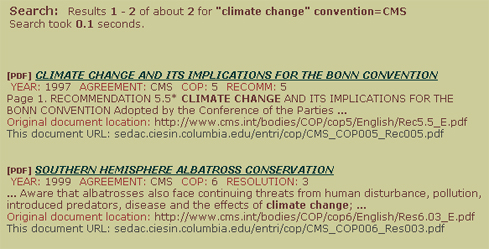News * Abou us * the ENB team * DONATE * Activities * Search * IISD RS home * IISD.org * RSS * What is RSS? * Links |
|
MEA Bulletin Guest Article (a)
Thursday,
20 December 2007
The New ENTRI Conference of Party (COP) Decision Search
Tool By Alex de Sherbinin, Center for International Earth Science Information Network (CIESIN), The Earth Institute at Columbia University The ToolEvery year the Parties to the major multi-lateral environmental agreements (MEAs) convene in exotic locations to make decisions affecting treaty implementation. As the number of agreements and COPs increase with every passing year, so do the number of decisions. It becomes increasingly difficult to track who decided what, and when, especially since decision documents are in different formats across multiple treaty secretariat websites. Furthermore, a particular decision of interest may be buried in a 100 page document for which the only option is to search the document using a text string and hope that the correct decision is located. In response to the challenge of locating decisions across multiple agreements, CIESIN’s NASA-funded Socioeconomic Data and Applications Center (SEDAC) has produced a COP Decision Search Tool as an add-on to its Environmental Treaties and Resource Indicators (ENTRI) project. The search tool is powered by a Google search appliance, and includes controlled "metadata" (coding of each decision document) so that you can perform powerful advanced searches by date, COP number, or title of document. All decisions are harvested as individual documents and converted to PDF for consistency. For reference purposes, we list the original URL of the document or Web page in which the decision may be found. The collection currently includes more than 2,100 decision documents for the following agreements: Convention on the Control of Transboundary Movements of Hazardous Wastes and their Disposal (Basel), Convention on Biological Diversity (CBD), Convention on International Trade in Endangered Species (CITES), Convention on Migratory Species (CMS), the Ramsar Convention on Wetlands of International Importance (Ramsar), UN Convention to Combat Desertification (CCD), UN Framework Convention on Climate Change (FCCC), Kyoto Protocol to the United Nations Framework Convention on Climate Change (Kyoto), Vienna Convention to Protect the Ozone Layer (Vienna), and the Montreal Protocol of the Vienna Convention (Montreal). Users may search across all ten agreements or limit the search to selected subsets. Using the Tool There a number of possible ways the tool can be used. The simplest approach is to conduct a free-text search across the texts of all decisions in the database and hope to come up with a useful results set. You may find just what you’re looking for, but depending on the term this may not yield a sufficiently small number of decisions. For example, searching on “sustainable development” yields 204 results. To narrow the search, a user might choose to retrieve only documents in which the title includes the search term (20 results), or might search on a subset of agreements that use the term in their decisions. In the case of CBD and CCD, the term is used in 91 decision documents. Another use might be to see how many times the Parties to the biodiversity agreements refer to climate change in their decisions, and how the agreements vary in their reference to it. Searching on “climate change” across the CBD, CITES, CMS, and Ramsar yields 75 decision documents, 48 for CBD, 0 for CITES, 2 for CMS, and 25 for Ramsar (Figure 1). This might give an indication of the relative importance of climate change to each of these MEAs. Figure 1. Sample results set for search including the term “climate change” for decisions produced by the Parties to the Convention on Migratory Species (CMS)
A similar search across all agreements on the term “remote sensing” finds that 17 decisions refer to it, all of them from Ramsar and CBD. To ensure that the universe of decisions is obtained, the user might want to search on related terms. In this case, searching on “earth observation” yields 3 decisions (2 of which are in FCCC), and searching on “satellite” yields 12 decisions (including some other agreements such as Vienna and CMS). Further effort would be required to determine if there is overlap among these results sets. More prosaic but nevertheless useful applications include searching for a specific decision based on its title, or finding decisions related to a topic that you remember was addressed by a certain agreement during some period of time. For example, “I remember that the Ramsar convention addressed the topic of indigenous people at some time in the 1990s.” Searching on “indigenous people” and restricting the query to Ramsar from 1990-1999 yields 13 results, 2 decisions at Ramsar COP 6 in 1996 and 11 decisions at Ramsar COP 7 in 1999. If you remembered only that the topic was raised at a Ramsar COP in Costa Rica, but could not remember the COP number or year, you could search on “Costa Rica” and limit the search to Ramsar, and the first document returned would be the “Thanks to the Host Country” for COP 7 in 1999. Then you could search on the term “indigenous people” for Ramsar COP 7 and find all the documents. The permutations of searches are virtually endless, depending on the specific requirements of the users. CIESIN intends to update the COP decisions every six months so as to keep the database of decisions relatively current. If you find a particularly useful application of this tool, please let us know, and we can add it to our FAQ file for the ENTRI service. (Contact Alex de Sherbinin at adesherbinin -a- ciesin.columbia.edu) To use the tool, visit http://sedac.ciesin.columbia.edu/gsametasearch/cop_start.jsp |


